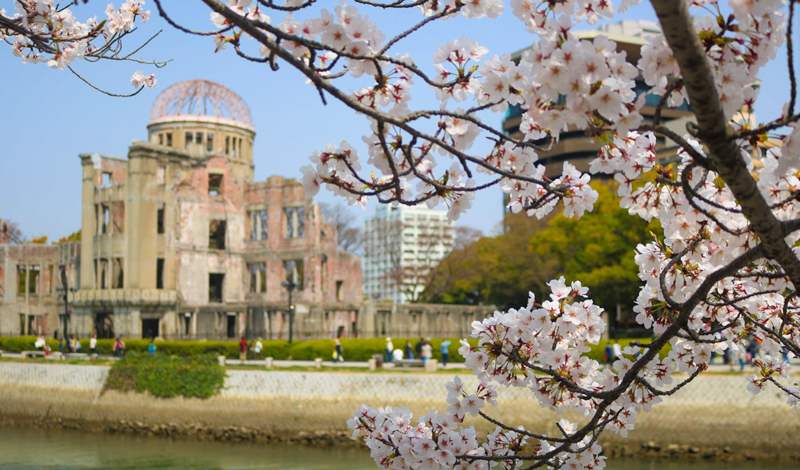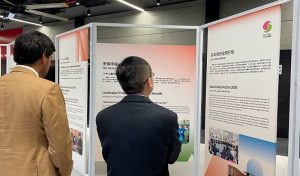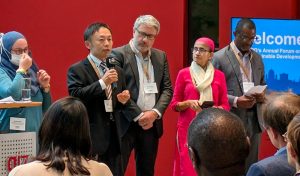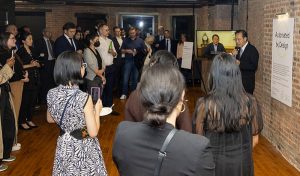The following was originally published in the April 27, 2023, issue of the Soka Gakkai’s daily newspaper, Seikyo Shimbun.
by Daisaku Ikeda
President, Soka Gakkai International
The Ukraine crisis, which in addition to bringing devastation to the people of that country has had severe impacts on a global scale—even giving rise to the specter of nuclear weapons use—has entered its second year. Against this backdrop and amid urgent calls for resolution, the G7 Summit of leading industrial nations will be held in Hiroshima, Japan, from May 19 to 21.
The holding of the G7 Summit in Hiroshima brings to mind the determination expressed by Dr. Bernard Lown, co-founder of International Physicians for the Prevention of Nuclear War (IPPNW). In March 1989, as the world was moving rapidly toward the conclusion of the Cold War, Dr. Lown came to Japan and visited Hiroshima. When we met in Tokyo he described the commitment that drove him to devote himself to efforts for peace, even as he continued his work as a cardiologist in the United States.
Dr. Lown said that as a physician he was motivated by the desire to save people from a tragic death, and that this feeling over time developed into the determination to abolish nuclear weapons, which can cause the death of humankind as a whole. This core determination was shared with fellow cardiovascular research specialist Dr. Yevgeny Chazov as they joined together across the Cold War divide to found IPPNW. The exchanges that sparked this new movement took place in December 1980, more than five years before the joint communiqué issued in November 1985 by U.S. President Ronald Reagan and Soviet General Secretary Mikhail Gorbachev in Geneva, which famously declared that “a nuclear war cannot be won and must never be fought.”[1]
The following year, in June 1986, Drs. Lown and Chazov traveled to Hiroshima, where they met with victims of the 1945 bombing who were hospitalized with its ongoing effects. The next day, they delivered a joint lecture at a symposium titled “Let’s Live Together, Not Die Together: What Must We Do Now to Prevent Nuclear War?” These words strike me as giving concise expression to the immediate feelings of physicians fully committed to protecting the lives of others. They also resonate with the determination of the survivors of the Hiroshima and Nagasaki nuclear bombings that the tragic impacts of nuclear weapons must never be experienced by anyone else on this planet.
In recent years, as the COVID-19 pandemic raged on and nations seemed to turn inward, the thing that undergirded international cooperation for public health was a spirit of solidarity embodied in the words: Let’s live together, not die together.
I strongly urge that, drawing on this spirit, efforts be made through the G7 Hiroshima Summit to find a path to the resolution of the Ukraine crisis that has wreaked devastation on so many people, and to reach clear agreement on preventing the use or threat of use of nuclear weapons.
Whereas the Cuban Missile Crisis held the world transfixed in terror for 13 days in October 1962, the Ukraine crisis has continued to escalate, as seen in Russia’s plan to station nuclear weapons in Belarus, attacks in the vicinity of nuclear power plants and the severing of the supply of electricity to them. Rafael Mariano Grossi, Director General of the International Atomic Energy Agency, has described each loss of electricity to a nuclear power plant as a roll of the dice, declaring: “If we allow this to continue time after time then one day our luck will run out.”[2] Indeed, the risk of catastrophe arising from the current path cannot be denied.
In February of this year, on the first anniversary of the crisis, an emergency special session of the U.N. General Assembly was held, where a resolution calling for the early realization of peace in Ukraine and expressing profound concern over the devastating impacts of the war on multiple global challenges such as food security and energy was adopted. Among the operative paragraphs of the resolution was one that urged the “immediate cessation of the attacks on the critical infrastructure of Ukraine and any deliberate attacks on civilian objects, including those that are residences, schools and hospitals.”[3] This call must be observed in order to prevent further suffering being inflicted on civilian populations.
With that as a first essential step, all concerned parties must come together to create a space for deliberations toward a complete cessation of hostilities. Here I would like to propose that, as negotiations advance through the cooperative efforts of the concerned countries, they be joined by representatives of civil society, such as the physicians and educators who work in schools and hospitals to protect and nurture people’s lives and futures, participating as observers.
Dr. Lown once characterized IPPNW’s activities as follows: Physicians have the kind of training and background that enables them to resist the dangerous tendency to stereotype our fellow humans. Further, they are trained to come up with workable solutions to problems that might at first glance seem impossible to resolve. He also called for humankind to work together across national differences to find a path to peace, describing this as “a prescription for hope.”[4] I believe that the qualities described by Dr. Lown and seen in the physicians who played a powerful role in furthering momentum for ending the Cold War are just those that must be deployed in order to achieve a breakthrough in the current crisis.
In March, the leaders of Russia and China issued a joint statement following their summit meeting which reads in part: “The two sides call for stopping all moves that lead to tensions and the protraction of fighting to prevent the crisis from getting worse or even out of control.”[5] This is aligned with the resolution adopted by the emergency special session of the U.N. General Assembly.
The G7 Hiroshima Summit should provide a “prescription for hope” by working for an immediate cessation of attacks on civilian objects and developing concrete plans for negotiations that will lead to a cessation of hostilities.
Together with working for the early resolution of the Ukraine crisis, I urge the G7 to commit at the Hiroshima Summit to taking the lead in discussions on pledges of No First Use of nuclear weapons. The current crisis is without parallel in the length of time that the threat of use and the fear of actual use of nuclear weapons have persisted without cease.
Recent years have seen the lapsing of the Intermediate-Range Nuclear Forces (INF) Treaty and the withdrawal of both the United States and Russia from the Open Skies Treaty, which aimed to build confidence among participating states. With tensions heightened by the Ukraine crisis, in February, Russia announced suspension of its participation in the New START (Strategic Arms Reduction Treaty), and the U.S. halted its sharing of data on nuclear forces with Russia. Should New START lapse, this could result in the complete loss of the frameworks—beginning with the signing of the Anti-Ballistic Missile (ABM) Treaty and the Strategic Arms Limitation Talks (SALT I) in 1972—designed to secure transparency and predictability around the two countries’ nuclear arsenals.
Since the bombings of Hiroshima and Nagasaki, the hibakusha of those cities, in coordination with the larger civil society movement, have stressed the inhumane nature of nuclear weapons; non-nuclear-weapon states have engaged in continuous diplomatic efforts; and the states possessing nuclear weapons have exercised self-restraint. As a result, the world has somehow managed to maintain a 77-year record of non-use of nuclear weapons.
If international public opinion and the taboo against the use of nuclear weapons were to fail to provide their braking function, nuclear deterrence policy—premised on the thinking that other countries’ nuclear weapons are dangerous but one’s own are the basis for security—will compel humankind to stand on a precipitous ledge, never knowing when it might give way.
On this basis, in January 2022, one month before the outbreak of the Ukraine crisis, I urged that, when Japan hosts the G7 Summit in 2023, a high-level meeting on reducing the role of nuclear weapons be held to create conditions conducive to establishing the principle of comprehensive non-use. The choice, I asserted, was between allowing New START, the last remaining measure taken in response to Nuclear Non-Proliferation Treaty (NPT) disarmament commitments, to lapse—thus perpetuating continued expansion of nuclear arsenals and the threat of their use—or crystalizing the historical weight of more than seventy-seven years of the non-use of nuclear weapons into a mutual pledge of No First Use among the nuclear-armed states, making this the crux of efforts to rebuild the NPT regime on new and firmer ground.
Since the start of the Ukraine crisis, I have written two public statements.[6] In both, I referenced the joint statement by the five nuclear-weapon states (United States, Russia, United Kingdom, France and China) made in January 2022, which reiterated the principle that “a nuclear war cannot be won and must never be fought,” and called for this statement to serve as the basis for reducing the risk of nuclear weapons use.
Also of important note is the shared awareness expressed by the declaration issued by the G20 group in Indonesia last November, which stated: “The use or threat of use of nuclear weapons is inadmissible.”[7]
The G20 member countries include the five nuclear-weapon states as well as nuclear-armed India. It further counts Germany, Italy, Canada, Japan, Australia and South Korea—all of whose security policies are dependent on nuclear weapons—among its members. It is deeply significant that these countries have officially expressed their shared recognition that the use or threat of use of nuclear weapons is “inadmissible”—the animating spirit of the Treaty on the Prohibition of Nuclear Weapons (TPNW) that entered into force in 2021.
The G20 Leaders’ Declaration also stressed that “Today’s era must not be of war.”[8] It is vital that these two messages be communicated powerfully to the world from Hiroshima.
As the G7 leaders revisit the actual consequences of a nuclear weapon detonation and the bitter lessons of the nuclear era, I urge that they initiate earnest deliberations on making pledges of No First Use so that their shared recognition of the inadmissible nature of nuclear weapons can find expression in changed policies.
The origins of the G7 process can be traced back to the Rambouillet Summit, held near Paris in 1975 in the midst of the Cold War and attended by the leaders of six countries. The Soka Gakkai International (SGI) was also established in 1975 and, taking to heart second Soka Gakkai President Josei Toda’s declaration calling for the abolition of nuclear weapons, which he had issued 18 years earlier as his final instructions to his successors, over the course of that year I visited all five nuclear-weapon states to engage in dialogue with prominent leaders and thinkers regarding paths to global peace.
Following my travels to these countries, on Nov. 9, I delivered a speech in Hiroshima in which I stressed the urgent need for the nuclear-weapon states to make declarations of No First Use and to extend negative security assurances, that is, guarantees never to use nuclear weapons against states not possessing them. Such steps, I urged, were a matter of highest priority in achieving the abolition of nuclear weapons. The upcoming summit meeting of the six leading countries in France was very much on my mind as I further called for an international peace conference to be held in Hiroshima as a first step toward nuclear weapons abolition.
My rationale for this proposal, I explained, was based on my firm belief that such high-level meetings where the interests of only the countries concerned and their national security are prioritized are meaningless unless they are redirected and used for the purpose of discussing the path toward nuclear abolition on which rests the destiny of humankind.
My conviction remains unchanged to this day, and these are the expectations I hold for the upcoming Hiroshima Summit.
Humankind has stepped up to the brink of nuclear war on multiple occasions, most dramatically during the Cuban Missile Crisis. Today, as the taboo against the use of nuclear weapons has been eroded among the nuclear-weapon states and frameworks for managing and reducing nuclear arsenals verge on collapse, there has never been a greater need to declare and establish policies of No First Use.
What is the nature of the security sought by the great majority of humankind?
In a report issued just weeks before the start of the Ukraine crisis, the United Nations Development Programme (UNDP) found that most people in the world feel insecure. The backdrop for this is a sense that human security—“the right of people to live in freedom and dignity, free from poverty and despair”[9]—has been eroded, feelings that were shared by more than 85 percent of respondents even several years before the start of the COVID-19 pandemic.
It is undeniable that this sense of insecurity has only been exacerbated by the impacts of the Ukraine crisis. In his foreword to the UNDP report, U.N. Secretary-General António Guterres voiced concern that “humankind is making the world an increasingly insecure and precarious place.”[10] My view is that the most essential factor here is the threat of nuclear weapons that has become so inextricably embedded in the way our world is structured.
The contrast with efforts to fight global warming is informative. Despite the stark reality of the crisis, recognizing that it is a priority issue concerning all humankind, meetings of the Conference of the Parties to the United Nations Framework Convention on Climate Change have been held on an annual basis, steadily building global consensus and solidarity for strengthening responses.
With regard to the nuclear issue, however, even as voices are raised advocating for disarmament, the nuclear-weapon and nuclear-dependent states regularly maintain that the challenging realities of their security environments mean the conditions for progress are not yet ripe.
If agreement could be reached on the principle of No First Use, which was at one point included in drafts of the final statement for last year’s NPT Review Conference, this would establish the basis on which states could together transform the challenging security environments in which they find themselves. I believe it is vital to make the shift to a “common security” paradigm congruent with the spirit “Let’s live together, not die together,” which has underpinned cooperative efforts among governments in the fight against climate change and in responses to the pandemic.
Commitment to policies of No First Use is indeed a “prescription for hope.” It can serve as the axle connecting the twin wheels of the NPT and TPNW, speeding realization of a world free from nuclear weapons.
For our part, the SGI has continued to work with the world’s hibakusha, International Campaign to Abolish Nuclear Weapons (ICAN)—which arose from the parent body of IPPNW—and other organizations first for the adoption and now the universalization of the TPNW. As members of civil society, we are committed to promoting the prompt adoption of policies of No First Use of nuclear weapons, generating momentum to transform the age.
Here I am reminded of Dr. Lown’s assessment of the significance of 1989. It was the year the Berlin Wall fell and the U.S. and Soviet leaders declared the end of the Cold War. When more than 3,000 physicians from East and West gathered for the IPPNW World Congress in Hiroshima that year, it was under the theme “No More Hiroshimas: An Eternal Commitment.” It was a year, he remarked, that should be celebrated for proving the power of ordinary people, which at first may seem ineffective but which can and did change the course of history.
It is said that the darker the night, the closer the dawn, and the end of the Cold War demonstrated the scale of energy unleashed when people who refuse to be defeated unite in solidarity.
Today, amid a political climate that some are even calling “a new cold war,” it is my fervent wish that constructive discussions that present a prescription for hope be undertaken at the G7 Summit in Hiroshima. I would also like to declare: Now is the time! Let us once again change the course of history through the power of people, paving a path toward a world free from nuclear weapons, a world free from war.
References
- Ronald Reagan Presidential Library and Museum, “Joint Soviet-United States Statement on the Summit Meeting in Geneva,” accessed April 27, 2023, https://www.reaganlibrary.gov/archives/speech/joint-soviet-united-states-statement-summit-meeting-geneva. ↩︎
- International Atomic Energy Agency, “Director General Statement to the Board of Governors – 9 March 2023,” accessed April 27, 2023, https://www.iaea.org/newscenter/pressreleases/director-general-statement-to-the-board-of-governors-9-march-2023. ↩︎
- United Nations, “Principles of the Charter of the United Nations Underlying a Comprehensive, Just and Lasting Peace in Ukraine,” accessed April 27, 2023, https://undocs.org/A/ES-11/L.7. ↩︎
- “International Physicians for the Prevention of Nuclear War: Nobel Lecture,” The Nobel Prize, accessed April 27, 2023, https://www.nobelprize.org/prizes/peace/1985/physicians/lecture/. ↩︎
- Ministry of Foreign Affairs of the People’s Republic of China, “President Xi Jinping and Russian President Vladimir Putin Sign Joint Statement of the People’s Republic of China and the Russian Federation on Deepening the Comprehensive Strategic Partnership of Coordination for the New Era and Stress Settling the Ukraine Crisis Through Dialogue,” accessed April 27, 2023, https://www.fmprc.gov.cn/eng/zxxx_662805/202303/t20230322_11046088.html. ↩︎
- Daisaku Ikeda, “Statement to 2022 NPT Review Conference Calling for No First Use of Nuclear Weapons,” July 26, 2022, accessed April 27, 2023, /sub/resources/works/lect/npt-statement-20220726.html.
Daisaku Ikeda, “Statement on the Ukraine Crisis and No First Use of Nuclear Weapons,” January 11, 2023, accessed April 27, 2023, /sub/resources/works/lect/2023jan11-stmt-on-ukraine-crisis-and-nfu.html. ↩︎
- G20, “G20 Bali Leaders’ Declaration, Bali, Indonesia, 15-16 November 2022,” accessed April 27, 2023, https://www.g20.org/content/dam/gtwenty/gtwenty_new/about_g20/previous-summit-documents/2022-bali/G20%20Bali%20Leaders%27%20Declaration,%2015-16%20November%202022.pdf. ↩︎
- Ibid. ↩︎
- United Nations, “Resolution Adopted by the General Assembly on 10 September 2012,” accessed April 27, 2023, https://www.un.org/humansecurity/wp-content/uploads/2022/06/N1147622.pdf. ↩︎
- António Guterres, “New Threats to Human Security in the Anthropocene,” UNDP, iii, accessed April 27, 2023, https://hdr.undp.org/system/files/documents/srhs2022pdf.pdf. ↩︎
You are reading {{ meterCount }} of {{ meterMax }} free premium articles





